Text
FINAL CURATED PORTFOLIO & Artists Statements



Movie Notes & Ideas:
Kurt Schwitters: Color & Collage(1/6)
1) What motivates these artists?
How do they go about collecting and assembling their work?
Collage artist
Expressionist movement - emphasis on specific colors is a take on “cubism”
Similar to “Brancusi”
A man who did everything - artist, performer, communicator,
“teeter Road”
Creative Maverick
Assemblage from artists Schwitters, Georgie Herms, Bette Saar and Robert Rauschenberg. (2/6)
First wood piece by George herms ,
takes garbage , nails, deteriorated wood, rusty cans
Poetry found in composition
Real composition, color and balance
Cast off materials of no value
Part of the LA art scene , vibrant
Kurt Schwitters - more color, various items, painting
pioneers in 1900s of using absolutely anything in ART
Adding color to his pieces
Formalist, used objects like stroke of paintbrush, another section
Using colors to have eyes travels across his work
Lines and curves , layering, almost collage with 3D
Bette Saar - 60s radical statements supporting black/civil rights movement
metaphors
Use of motherboards
Black girls window 1969
Racism and mystical spiritual qualities
Joseph Cornell - repeating iconography , mysterious worlds,
shadowboxes
Elegance - mostly white
Cockatoo with corks
The Medici princess !
Robert Raushenberg
formal - everything is dealing with principles of design
The Bergman Collection of Joseph Cornell(3/6)
petit museum - cabinet of curiosities
Fascinated with film , ballet , trinkets of dancers jewelry incorporated
Thinking outside the Box: (4/6)
Louise Nevelson at Kykuit
1) What motivates these artists?
How do they go about collecting and assembling their work?
atmosphere and environment VI
1 of 13 scuptures made when started working with metal ( mid 60s)
known for working mostly with wood
First was a painter - learned about cubism and Picasso
Large scale sculpture
Background in theater
dressing in black, long lash , eccentric woman - projecting personality
Working with basic planar vocabulary, and geometry in an underlying grid
I’m “push & pull”’ concept
Black wood , found objects, ready - made objects
Scavenge the streets of New York looking for furniture parts and wooden liquorboxes
Known for stacking boxes
Inspired. By the Yucatán peninsula & ruins in Central America and ,Mexico
Avid collector of Native American art & African art
Ritualistic quality /Shrine “
Ensembles and room environments — “Moon Garden Plus One” a continuous sculptural enclosure, as she calls it.
Reason why she switched to metals is for “permanence “ allowed for display of installations through the seasons :) (love the snowy cubism “
Why she chose color black? Answer : she was in a world of geometry and magic, she did not want color to help her
It wasn’t a negation of color, it was an acceptance, because black ecompasses all colors
Subconscious expressions of moods / world turned upside down when her son was a soldier in WW2 - coffin like boxes - black - enclosed - secrecy within herself ‘
Also the world was war - the idea that everyone was affected
After divorce, she married the world by switching to the color “white”
Nelson Rockefeller owned an ensemble and commissioned her work circa 1959
Ahead of her time - cusp in the movement of rising “minimalism” as she works with geometric Units
Worked in , black white, gold
Idea that you can place the sculpture outside and it changes the way you look at it, beauty , the way the light hits,
Plexiglass “Ice Palace” 1967
Went from shadows to light
Used shadows as forms / and reflections as forms
Her works was all about energy!!
Look up artists:
Donald Judd - American artist - variations of tubes and cubes - 60s and 70s
Frank Stella - protractor paintings - “art deco effect”
Roy Lichtenstein
Reflection:
The artist I remembered the most as I was traversing through the lives of these fascinating thinkers and creators, was — Louise Nevelson. She was eclectic, and stylish in her demeanor, having a background in theater, her art very much resembles my nature within energetic forms of depth and symmetry. Inspired by her visitations to the Yucatán peninsula and ruins of Mexico, I connect with the spiritual and mystical aspect of her work. The fact that she always worked in black as an acceptance of truth “encompassing all colors” was a beautiful endeavor. Boldly moving from different materials from wood to metal then later to Plexiglass, each medium allowing for staggering debuts of beauty highlighting her career as notable people like Nelson Rockefeller later purchased and commissioned her work in 1959.
Louise Nevelson: Mrs. N’s Palace - Met Museum (5/6)
eclectic
Surrealism
Energetic, indigenous / tribal with the sticks protruding / barrels
All black, matte , optical illusions in depth
Reflection .01
The artist I remembered the most as I was traversing through the lives of these fascinating thinkers and creators, was — Louise Nevelson. She was eclectic, and stylish in her demeanor, having a background in theater, her art very much resembles my nature within energetic forms of depth and symmetry. Inspired by her visitations to the Yucatán peninsula and ruins of Mexico, I connect with the spiritual and mystical aspect of her work. The fact that she always worked in black as an acceptance of truth “encompassing all colors” was a beautiful endeavor. Boldly moving from different materials from wood to metal then later to Plexiglass, each medium allowing for staggering debuts of beauty highlighting her career, as notable people like Nelson Rockefeller later purchased and commissioned her work in 1959.
I really like how George Herms gives value to casted off materials, essentially creating poetry metaphorically in His compositions. But really, it’s when Kurt Schwitters makes the eye travel. He and I share a lot of common characteristics and talents (artist, performer, communicator) making his art more attractive to me almost automatically.
My favorite work from Bette Saar is the Black girl’s window created in 1969. It’s a dreamy nighttime window displaying a child looking out to the stars—her hands inscribed with stars/symbology. I admire her bold radical statements in the 60s shown in her work as a supporter of the civil rights movement. Her medium was similar to Schwitters and Herms when it came to collecting random, cast off materials of various shapes and forms— Sometimes adding color to balance the composition etc.
Joseph Cornell on the other hand focused more on repeating iconography. He worked Mostly with white colors displaying a particular elegance. He devoted a series to his love for cockatoo birds where the division of space like “shadowboxes” within an assemblage was uniquely crafted to resemble a room for the bird.
All I can say about Robert Rauschenberg is that he went really formal, and conventional - building on a series of amazing work built upon the greatest pioneers of stacking, cubism and geometric forms. I started taking Ballet as an adult this year. I speculate this was caused by my fire arts career demanding a contemporary style of dance over the past few years that I can only assume would have sparked a curiosity and attraction to the form of Ballet. This is something Joseph Cornell and I share in common, As he sometimes incorporated trinkets of ballet dancers into his artwork as well as admired dance and film.
Process photos from assemblage.



Assemblage- side by side photo of final product and artist statement and title.


Artist Statement: Homemade Harmonies
In my assemblage project, "Homespun Harmonies," I examine the personal stories in common things. This 12X12 foot wall-hanging features antique letters, broken timepieces, and faded fabric pieces carefully arranged to highlight their individual stories of my personal life.
This project explores memory and time. My home's objects form a physical timeline of life's stages. These stories are combined to create a new narrative that shows how human experiences are interconnected.
I carefully selected and placed each item to ensure harmony. I used adhesives and stitches to balance the composition and preserve the products' integrity, combining modern and traditional making methods.
"Homespun Harmonies" blends personal history with cultural critique, influenced by Joseph Cornell's assemblages and Louise Nevelson's conceptual methods. This piece evokes nostalgia and contemplation, encouraging spectators to consider their memories and their things.
This project expresses my personal background and continues my investigation of found object narratives, using the commonplace to get deeper insight.
Artist Statement: Homemade Harmonies
In my assemblage project, "Homespun Harmonies," I examine the personal stories in common things. This 12X12 foot wall-hanging features antique letters, broken timepieces, and faded fabric pieces carefully arranged to highlight their individual stories of my personal life.
This project explores memory and time. My home's objects form a physical timeline of life's stages. These stories are combined to create a new narrative that shows how human experiences are interconnected.
I carefully selected and placed each item to ensure harmony. I used adhesives and stitches to balance the composition and preserve the products' integrity, combining modern and traditional making methods.
"Homespun Harmonies" blends personal history with cultural critique, influenced by Joseph Cornell's assemblages and Louise Nevelson's conceptual methods. This piece evokes nostalgia and contemplation, encouraging spectators to consider their memories and their things.
This project expresses my personal background and continues my investigation of found object narratives, using the commonplace to get deeper insight.
Artist Statement: Homemade Harmonies
In my assemblage project, "Homespun Harmonies," I examine the personal stories in common things. This 12X12 foot wall-hanging features antique letters, broken timepieces, and faded fabric pieces carefully arranged to highlight their individual stories of my personal life.
This project explores memory and time. My home's objects form a physical timeline of life's stages. These stories are combined to create a new narrative that shows how human experiences are interconnected.
I carefully selected and placed each item to ensure harmony. I used adhesives and stitches to balance the composition and preserve the products' integrity, combining modern and traditional making methods.
"Homespun Harmonies" blends personal history with cultural critique, influenced by Joseph Cornell's assemblages and Louise Nevelson's conceptual methods. This piece evokes nostalgia and contemplation, encouraging spectators to consider their memories and their things.
This project expresses my personal background and continues my investigation of found object narratives, using the commonplace to get deeper insight.
Process work for Soap Sculpture
Photo shoot of soap and final product with artist statement and title








Artist Statement: Soap Henge
"Soap Henge" is a soap sculpture that evokes ancient stone circles' mysticism and majesty. This project for my 3D art class comprises a series of hand-carved soap blocks organized in a circle with at least three apertures to represent doorways to other realms or states of consciousness.
This artwork contrasts soap's transience with Stonehenge's megalithic stones' durability. I use soap, which degrades with time, to symbolize the transience of even the greatest creations and human history.
Soap sculpting required careful planning and execution. To achieve the look of aged stones and structural integrity, each block was carefully molded. Each sculpture's openings aligned to provide new visual viewpoints and light interactions as the visitor wanders around it.
"Soap Henge" is inspired by the old and timeless and minimalist art, where form and material conceal depth. I want to talk about time, transformation, and how art connects the past and present in this piece.
In "Soap Henge," I ask viewers to consider human cultural expression and art's fleeting but powerful character. This project is a stage in my exploration of using odd materials to make sculptures that are both beautiful and symbolic.
Ephemeral Art - process photos
Ephemeral art - completed project and photo shoot with artist statement and title.





Artist Statement
In my piece, "Stickma," I used natural forms and structures to build an ephemeral sculpture that resembles the Sydney Opera House. I like this project since it included carefully collecting similar sticks from nature and then arranging them with super glue to stretch the natural lines and curves into a flowing, architectural form.
A fascination with how ignored natural items can become complex, identifiable constructions inspired this piece. I arranged these sticks to show how organic architectural elegance and natural materials may reflect human inventiveness and engineering.
I started by hand-picking sticks from diverse natural environments that were similar in size and shape that could bend and intersect to mimic the Sydney Opera House's expressionist design. The physical assembly, form balance, and material temporality were all challenges.
"Stickma" contemplates the transience of live art. It encourages viewers to ponder the transience of natural and man-made wonders and the beauty that results from human aim and natural development.
This piece invites spectators to engage with the natural world, find beauty in simplicity, and see similarities between great architecture and nature. This sculpture pays homage to an architectural landmark and contemplates the possibility of transforming the ordinary into the remarkable.


Accepted Artwork : Miami Dade Kendal Student Art Jurie Show
To Be Continued on next Post : As we are only allowed 30 images per post.
1 note
·
View note
Text
Final Artist Statement:
“Sculptural Explorations”
This semester has been an exploration of many sculptural techniques and philosophical investigations, with each project demonstrating a distinct artistic process: additive, subtractive, constructive, and critical thinking.
1. Additive Process: Homemade Harmonies.
My experimentation with additive techniques was shown in "Homespun Harmonies," a collection of personal and domestic things that tell a communal story. This project allows me to layer histories and meanings, physically assembling components to form a coherent narrative tableau.
Subtractive Process: Soap Henge.
"Soap Henge" used the subtractive process, which involved cutting soap to create free-form constructions that resembled henge stones, replete with 'eyes'—a result of the requirement to include three apertures in each piece. This technique entailed meticulously removing material to sculpt each soap piece into an abstract shape that conveyed both solidity and fragility. The openings changed these structures, adding visual interest and producing a lively interplay of light and shadow, similar to old monolithic henges. This project not only simplified physical materials, but also investigated the use of negative space as a dynamic element in sculpture.
3. Constructive Process: Nature's Blueprint.
The ephemeral project "Stickma" was my experiment with constructive methods, in which I constructed discovered sticks from nature to create a form. This method entailed creating complicated shapes from simple natural elements, stressing form and space in a direct, tactile manner.
4. Critical Thinking: Ceramic Sculpture
Our ceramic sculpture was a critical thinking exercise in which we had to manipulate clay in ways that needed preparation and planning to attain the desired results. This project required an awareness of the medium's limitations and potential, forcing us to think ahead in our creative executions.
Favorite process: Ephemeral sculpture.
Among these techniques, the ephemeral sculpture "Stickma" was most meaningful to me. It connected me to the prosaic yet majestic features of nature, helping me to elevate the ordinary into the spectacular. This project was about more than just making art; it was about encouraging a deep, introspective relationship with the environment, emphasizing the fleeting yet profound nature of our interactions with the natural world.
I've spent this semester exploring different materials and processes, and I've grown to love the natural aspects in my ephemeral sculpture piece, "Stickma." Tactile, organic wood allowed for a visceral, hands-on creative process that tested my mechanical skills and deepened my mental understanding. This project was my favorite because it connected me to nature's simplicity and complexity, inspiring me to make a meaningful edifice from sticks.
From learning soap carving to finding the right natural ingredients, I faced several challenges. Every challenge was an opportunity to adapt and develop, whether it was improving my carving technique to achieve "Soap Henge"'s delicate balance or trying new adhesives and configurations to stabilize my assemblages. Overcoming these challenges has improved my problem-solving and resilience, preparing me for FIU's tough academic environment. As I prepare to transfer and advance in my career, I am excited to try new materials, scale up my work, and combine classic and contemporary approaches to produce art that inspires others.
Sketchbook Usage
Throughout the semester, my sketchbook was an invaluable ally, acting as a visual journal with each page serving as a canvas for ideas and experiments. It contained sketches, material samples, and notes that were later developed into full project blueprints. This ongoing practice of sketching and reflecting was critical for developing and improving my notions and skills.
Recommendation
I heartily suggest this course to anyone interested in learning about the depth and range of sculptural sculpture. It offers a thorough grounding in several artistic techniques, fostering both technical skill development and conceptual depth. This program is more than just learning to create; it is also about learning to observe and think about art in profoundly altering ways.
0 notes
Text





Artist Statement
In my piece, "Stickma," I used natural forms and structures to build an ephemeral sculpture that resembles the Sydney Opera House. I like this project since it included carefully collecting similar sticks from nature and then arranging them with super glue to stretch the natural lines and curves into a flowing, architectural form.
A fascination with how ignored natural items can become complex, identifiable constructions inspired this piece. I arranged these sticks to show how organic architectural elegance and natural materials may reflect human inventiveness and engineering.
I started by hand-picking sticks from diverse natural environments that were similar in size and shape that could bend and intersect to mimic the Sydney Opera House's expressionist design. The physical assembly, form balance, and material temporality were all challenges.
"Stickma" contemplates the transience of live art. It encourages viewers to ponder the transience of natural and man-made wonders and the beauty that results from human aim and natural development.
This piece invites spectators to engage with the natural world, find beauty in simplicity, and see similarities between great architecture and nature. This sculpture pays homage to an architectural landmark and contemplates the possibility of transforming the ordinary into the remarkable.
0 notes
Text









Artist Statement: Soap Henge
"Soap Henge" is a soap sculpture that evokes ancient stone circles' mysticism and majesty. This project for my 3D art class comprises a series of hand-carved soap blocks organized in a circle with at least three apertures to represent doorways to other realms or states of consciousness.
This artwork contrasts soap's transience with Stonehenge's megalithic stones' durability. I use soap, which degrades with time, to symbolize the transience of even the greatest creations and human history.
Soap sculpting required careful planning and execution. To achieve the look of aged stones and structural integrity, each block was carefully molded. Each sculpture's openings aligned to provide new visual viewpoints and light interactions as the visitor wanders around it.
"Soap Henge" is inspired by the old and timeless and minimalist art, where form and material conceal depth. I want to talk about time, transformation, and how art connects the past and present in this piece.
In "Soap Henge," I ask viewers to consider human cultural expression and art's fleeting but powerful character. This project is a stage in my exploration of using odd materials to make sculptures that are both beautiful and symbolic.
0 notes
Text




Artist Statement: Homemade Harmonies
In my assemblage project, "Homespun Harmonies," I examine the personal stories in common things. This 12X12 foot wall-hanging features antique letters, broken timepieces, and faded fabric pieces carefully arranged to highlight their individual stories of my personal life.
This project explores memory and time. My home's objects form a physical timeline of life's stages. These stories are combined to create a new narrative that shows how human experiences are interconnected.
I carefully selected and placed each item to ensure harmony. I used adhesives and stitches to balance the composition and preserve the products' integrity, combining modern and traditional making methods.
"Homespun Harmonies" blends personal history with cultural critique, influenced by Joseph Cornell's assemblages and Louise Nevelson's conceptual methods. This piece evokes nostalgia and contemplation, encouraging spectators to consider their memories and their things.
This project expresses my personal background and continues my investigation of found object narratives, using the commonplace to get deeper insight.
0 notes
Text
Movie Notes & Ideas:
Kurt Schwitters: Color & Collage(1/6)
1) What motivates these artists?
How do they go about collecting and assembling their work?
Collage artist
Expressionist movement - emphasis on specific colors is a take on “cubism”
Similar to “Brancusi”
A man who did everything - artist, performer, communicator,
“teeter Road”
Creative Maverick
Assemblage from artists Schwitters, Georgie Herms, Bette Saar and Robert Rauschenberg. (2/6)
First wood piece by George herms ,
takes garbage , nails, deteriorated wood, rusty cans
Poetry found in composition
Real composition, color and balance
Cast off materials of no value
Part of the LA art scene , vibrant
Kurt Schwitters - more color, various items, painting
pioneers in 1900s of using absolutely anything in ART
Adding color to his pieces
Formalist, used objects like stroke of paintbrush, another section
Using colors to have eyes travels across his work
Lines and curves , layering, almost collage with 3D
Bette Saar - 60s radical statements supporting black/civil rights movement
metaphors
Use of motherboards
Black girls window 1969
Racism and mystical spiritual qualities
Joseph Cornell - repeating iconography , mysterious worlds,
shadowboxes
Elegance - mostly white
Cockatoo with corks
The Medici princess !
Robert Raushenberg
formal - everything is dealing with principles of design
The Bergman Collection of Joseph Cornell(3/6)
petit museum - cabinet of curiosities
Fascinated with film , ballet , trinkets of dancers jewelry incorporated
Thinking outside the Box: (4/6)
Louise Nevelson at Kykuit
1) What motivates these artists?
How do they go about collecting and assembling their work?
atmosphere and environment VI
1 of 13 scuptures made when started working with metal ( mid 60s)
known for working mostly with wood
First was a painter - learned about cubism and Picasso
Large scale sculpture
Background in theater
dressing in black, long lash , eccentric woman - projecting personality
Working with basic planar vocabulary, and geometry in an underlying grid
I’m “push & pull”’ concept
Black wood , found objects, ready - made objects
Scavenge the streets of New York looking for furniture parts and wooden liquorboxes
Known for stacking boxes
Inspired. By the Yucatán peninsula & ruins in Central America and ,Mexico
Avid collector of Native American art & African art
Ritualistic quality /Shrine “
Ensembles and room environments — “Moon Garden Plus One” a continuous sculptural enclosure, as she calls it.
Reason why she switched to metals is for “permanence “ allowed for display of installations through the seasons :) (love the snowy cubism “
Why she chose color black? Answer : she was in a world of geometry and magic, she did not want color to help her
It wasn’t a negation of color, it was an acceptance, because black ecompasses all colors
Subconscious expressions of moods / world turned upside down when her son was a soldier in WW2 - coffin like boxes - black - enclosed - secrecy within herself ‘
Also the world was war - the idea that everyone was affected
After divorce, she married the world by switching to the color “white”
Nelson Rockefeller owned an ensemble and commissioned her work circa 1959
Ahead of her time - cusp in the movement of rising “minimalism” as she works with geometric Units
Worked in , black white, gold
Idea that you can place the sculpture outside and it changes the way you look at it, beauty , the way the light hits,
Plexiglass “Ice Palace” 1967
Went from shadows to light
Used shadows as forms / and reflections as forms
Her works was all about energy!!
Look up artists:
Donald Judd - American artist - variations of tubes and cubes - 60s and 70s
Frank Stella - protractor paintings - “art deco effect”
Roy Lichtenstein
Reflection:
The artist I remembered the most as I was traversing through the lives of these fascinating thinkers and creators, was — Louise Nevelson. She was eclectic, and stylish in her demeanor, having a background in theater, her art very much resembles my nature within energetic forms of depth and symmetry. Inspired by her visitations to the Yucatán peninsula and ruins of Mexico, I connect with the spiritual and mystical aspect of her work. The fact that she always worked in black as an acceptance of truth “encompassing all colors” was a beautiful endeavor. Boldly moving from different materials from wood to metal then later to Plexiglass, each medium allowing for staggering debuts of beauty highlighting her career as notable people like Nelson Rockefeller later purchased and commissioned her work in 1959.
Louise Nevelson: Mrs. N’s Palace - Met Museum (5/6)
eclectic
Surrealism
Energetic, indigenous / tribal with the sticks protruding / barrels
All black, matte , optical illusions in depth
0 notes
Text

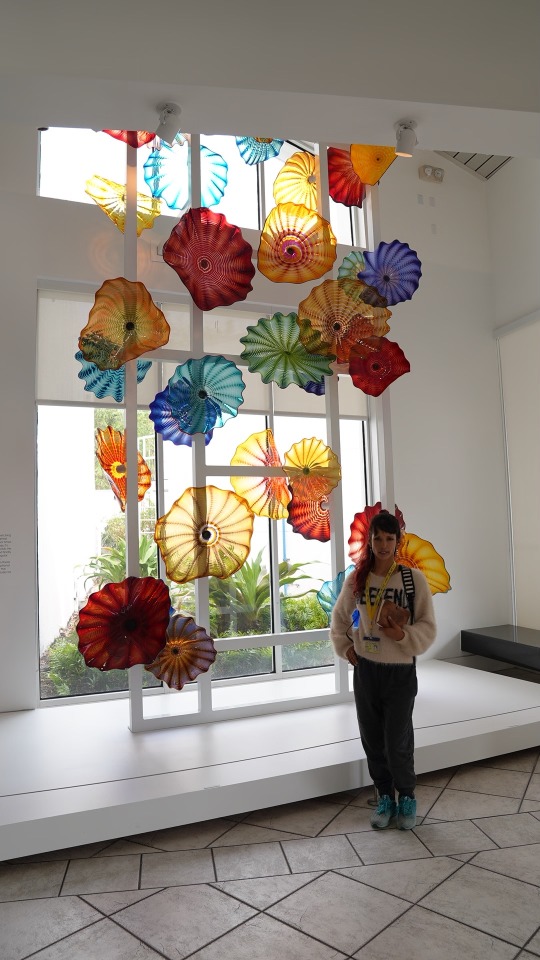

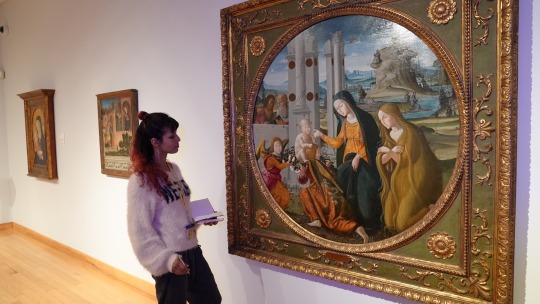
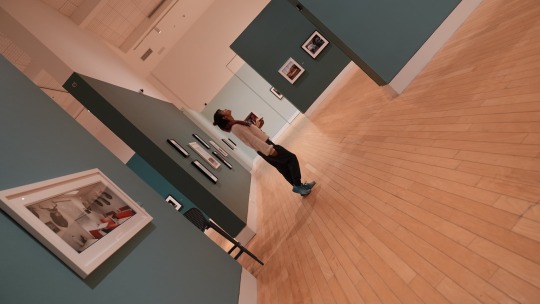



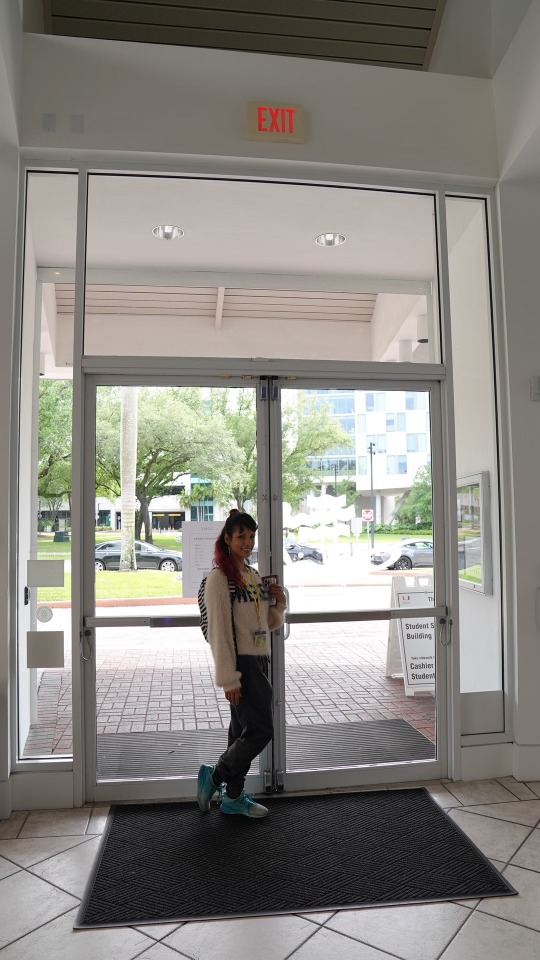
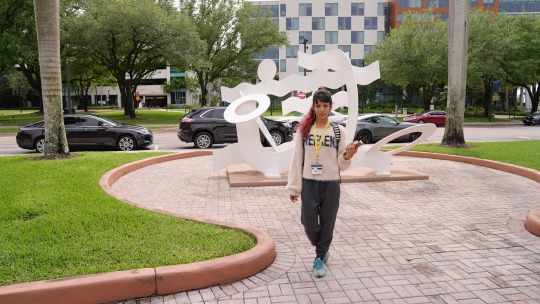
A day at the Lowe Museum ✨
@artleaguemdcnorth
0 notes
Text



MoCA North Miami Museum: Notes and Sketches
0 notes
Text




Carving adventures with Ms. apple & Mr. potato
0 notes
Text


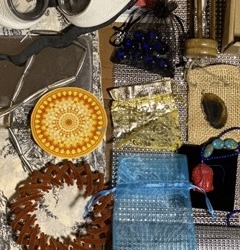

Items collected around my home for Assemblage project .01
#wood #bamboo #trinkets #collage #assemblage #eclectic
0 notes
Text
Reflection .01
The artist I remembered the most as I was traversing through the lives of these fascinating thinkers and creators, was — Louise Nevelson. She was eclectic, and stylish in her demeanor, having a background in theater, her art very much resembles my nature within energetic forms of depth and symmetry. Inspired by her visitations to the Yucatán peninsula and ruins of Mexico, I connect with the spiritual and mystical aspect of her work. The fact that she always worked in black as an acceptance of truth “encompassing all colors” was a beautiful endeavor. Boldly moving from different materials from wood to metal then later to Plexiglass, each medium allowing for staggering debuts of beauty highlighting her career, as notable people like Nelson Rockefeller later purchased and commissioned her work in 1959.
I really like how George Herms gives value to casted off materials, essentially creating poetry metaphorically in His compositions. But really, it’s when Kurt Schwitters makes the eye travel. He and I share a lot of common characteristics and talents (artist, performer, communicator) making his art more attractive to me almost automatically.
My favorite work from Bette Saar is the Black girl’s window created in 1969. It’s a dreamy nighttime window displaying a child looking out to the stars—her hands inscribed with stars/symbology. I admire her bold radical statements in the 60s shown in her work as a supporter of the civil rights movement. Her medium was similar to Schwitters and Herms when it came to collecting random, cast off materials of various shapes and forms— Sometimes adding color to balance the composition etc.
Joseph Cornell on the other hand focused more on repeating iconography. He worked Mostly with white colors displaying a particular elegance. He devoted a series to his love for cockatoo birds where the division of space like “shadowboxes” within an assemblage was uniquely crafted to resemble a room for the bird.
All I can say about Robert Rauschenberg is that he went really formal, and conventional - building on a series of amazing work built upon the greatest pioneers of stacking, cubism and geometric forms. I started taking Ballet as an adult this year. I speculate this was caused by my fire arts career demanding a contemporary style of dance over the past few years that I can only assume would have sparked a curiosity and attraction to the form of Ballet. This is something Joseph Cornell and I share in common, As he sometimes incorporated trinkets of ballet dancers into his artwork as well as admired dance and film.


1 note
·
View note

















